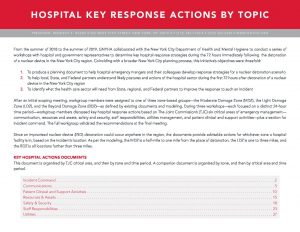From the summer of 2018 to the summer of 2019, GNYHA collaborated with the New York City Department of Health and Mental Hygiene to conduct a series of workshops with hospital and government representatives to determine key hospital response strategies during the 72 hours immediately following the detonation of a nuclear device in the New York City region. Coinciding with a broader New York City planning process, this initiative’s objectives were threefold:
- To produce a planning document to help hospital emergency mangers and their colleagues develop response strategies for a nuclear detonation scenario
- To help local, State, and Federal partners understand likely postures and actions of the hospital sector during the first 72 hours after detonation of a nuclear device in the New York City region
- To identify what the health care sector will need from State, regional, and Federal partners to improve the response to such an incident
After an initial scoping meeting, workgroup members were assigned to one of three zone-based groups—the Moderate Damage Zone (MDZ), the Light Damage Zone (LDZ), and the Beyond Damage Zone (BDZ)—as defined by existing documents and modeling. During three workshops—each focused on a distinct 24-hour time period—workgroup members discussed key hospital response actions based on The Joint Commission’s (TJC) six critical areas of emergency management—communication, resources and assets, safety and security, staff responsibilities, utilities management, and patient clinical and support activities—plus a section for incident command. The full workgroup validated the recommendations at the final meeting.
Since an improvised nuclear device (IND) detonation could occur anywhere in the region, the documents provide advisable actions for whichever zone a hospital facility is in, based on the incident’s location. As per the modeling, the MDZ is a half-mile to one mile from the place of detonation, the LDZ is one to three miles, and the BDZ is all locations farther than three miles.
Key Hospital Actions Documents
This document is organized by TJC critical area, and then by zone and time period. A companion document is organized by zone, and then by critical area and time period.
